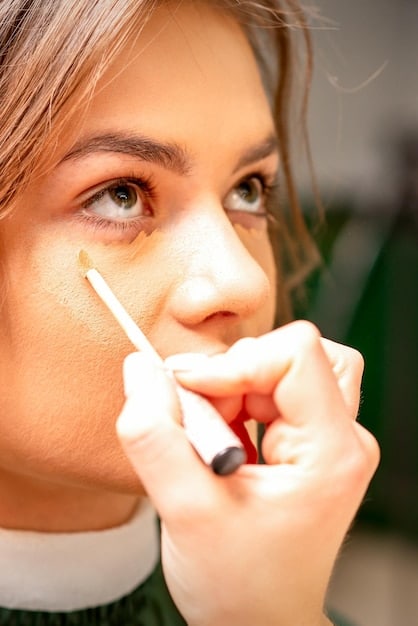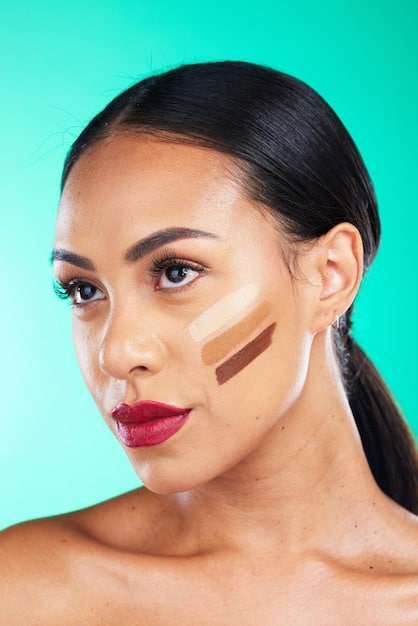Prevent Creasing Under Your Eyes: The 2025 Concealer Guide

Advertisements
Preventing creasing under your eyes involves selecting the right concealer, prepping the skin with hydration, applying the concealer strategically, setting it properly, and maintaining skin health to minimize fine lines and wrinkles, ensuring a flawless look.
Tired of your concealer settling into fine lines and making you look older than you are? The struggle is real, but don’t worry! This guide will show you how to prevent creasing under your eyes: a 2025 concealer guide, and achieve a smooth, flawless finish.
Advertisements
Understanding Under-Eye Creasing
Under-eye creasing occurs when concealer settles into the fine lines and wrinkles around your eyes, accentuating them rather than concealing them. Several factors contribute to this common makeup woe, and understanding them is the first step in preventing it.
Causes of Under-Eye Creasing
Several elements contribute to concealer creasing. Recognizing these causes allows focused efforts to solve the issue efficiently. Here are a couple of elements:
Advertisements
- Dryness: Dehydrated skin lacks elasticity, making fine lines more prominent.
- Product Overload: Applying too much concealer can lead to settling and creasing.

How Skin Type Affects Creasing
Different skin types react differently to concealer. For example:
- Oily Skin: Natural oils can break down concealer, causing it to slip into lines.
- Mature Skin: Loss of collagen and elasticity increases the likelihood of creasing.
Understanding the causes and how your skin type affects creasing is the initial step. The subsequent sections will examine skin preparation and concealer selection to lessen the effect.
Prepping Your Under-Eye Area
Properly preparing your under-eye area is crucial for preventing concealer from creasing. Hydration, exfoliation, and targeted treatments can create a smooth canvas, ensuring your concealer applies flawlessly.
Hydration is Key
Hydration plumps up fine lines, making them less visible. Proper hydration is essential to prevent the concealer from settling into any creases.
Use hydrating eye creams and serums. Look for ingredients like hyaluronic acid and glycerin, which attract and retain moisture. Apply these products both morning and night to keep the under-eye area well-hydrated.
Exfoliation Techniques
Gentle exfoliation removes dead skin cells. Exfoliation removes rough texture that can cause makeup to crease.
Use a very gentle exfoliator 1-2 times a week. Avoid harsh scrubs, which can irritate the delicate skin around your eyes. Chemical exfoliants like lactic acid can also be effective but should be used with caution.
Targeted Treatments
Specialized treatments can nourish the skin, promoting a smooth base for makeup.
Consider using eye masks and serums that target fine lines and wrinkles. Ingredients like peptides and retinol can help improve skin elasticity and reduce the appearance of signs of aging.
Appropriate preparation of the under-eye area is vital to achieving a smooth, crease-free base for concealer application. The proper measures can dramatically impact your makeup’s overall appearance and longevity.
Choosing the Right Concealer
Selecting the right concealer is pivotal in preventing creasing. Different formulations and ingredients cater to various skin types and concerns, and the right choice can make all the difference.
Concealer Formulations
The formulation of your concealer affects how it sits on the skin and its likelihood of creasing. Consider these options:
- Liquid Concealers: Lightweight and blendable, ideal for dry or mature skin.
- Cream Concealers: Offer more coverage, suitable for oily or combination skin.
Ingredients to Look For
Certain ingredients can hydrate, smooth, or provide anti-aging benefits. Keep these in mind when hunting for the right concealer product:
- Hyaluronic Acid: Hydrates and plumps the skin.
- Peptides: Promote collagen production and firmness.
Comparing Concealer Brands
Many brands offer concealers designed to resist creasing. Here are a few popular ones that are known for not creasing during the day:
- NARS Radiant Creamy Concealer
- Tarte Shape Tape
- Fenty Beauty Pro Filt’r Instant Retouch Concealer
Choosing the right concealer involves understanding different formulations and key ingredients and selecting a brand that suits your skin type. This will set the stage for a flawless, crease-free finish.

Application Techniques That Minimize Creasing
The way you apply your concealer significantly impacts whether it creases or stays smooth. Proper techniques can prevent product buildup, ensure even coverage, and keep your under-eyes looking flawless.
The Dotting Method
Applying concealer in small dots prevents product overload. This technique to apply involves gently dabbing smaller amounts to ensure minimal product buildup.
Dab small dots of concealer under your eyes, focusing on areas with darkness or discoloration. Start with a minimal amount and build up coverage as needed. Avoid swiping or dragging, which can stretch the skin and cause creasing.
Blending Tools
Using the right tools makes a difference in how well the concealer sits on the skin. Using blending tools can prevent buildup in one area.
Use a damp makeup sponge or a soft blending brush to gently blend the concealer into your skin. Pat or stipple the product rather than rubbing it in to avoid disturbing the skin. Ensure the concealer is seamlessly integrated with your foundation.
Setting with Powder
Setting your concealer with powder locks it in place and absorbs excess oil. Using a powder locks the concealer for long wear.
Use a finely milled setting powder to lightly dust over the concealer. A small, fluffy brush works best for precise application. Be careful not to use too much powder, as it can accentuate dryness and fine lines.
The application techniques for concealer greatly affect creasing and product buildup. Following these steps encourages a smooth, long-wearing, and crease-free application.
Setting Strategies for Longevity
Setting your concealer properly is crucial for long-lasting wear and preventing creasing throughout the day. Different setting methods cater to various skin types and makeup preferences, ensuring a flawless finish.
Choosing the Right Powder
Selecting the right setting powder is essential, and several factors need to be considered. Be sure that the one you choose meets your specific requirements for optimal performance. Here are a couple of choices:
- Loose Powders: Offer a natural, airbrushed finish, ideal for setting large areas.
- Pressed Powders: Convenient for on-the-go touch-ups, provide more coverage.
Baking vs. Light Setting
Baking and light setting are two popular methods for setting concealer. Baking involves applying setting powder to the under-eye area and letting it sit for several minutes before dusting it off, while light setting involves a light dusting of powder.
- Baking: Provides a matte, long-lasting finish, best for oily skin.
- Light Setting: Sets the concealer without adding excess product, ideal for dry or mature skin.
Maintaining Throughout the Day
Touch-ups can help maintain a smooth, crease-free look. Be sure to gently pat your under eyes with a sponge instead of smearing if you notice creasing.
Carry blotting papers to absorb excess oil and prevent concealer from breaking down. If you notice creasing, gently pat the area with a damp makeup sponge or your fingertip to redistribute the product. Reapply a light dusting of setting powder as needed.
Mastering setting strategies extends the wear of your concealer, which stops creasing. Customize the approach based on skin type and lifestyle requirements to keep a smooth under-eye area all day.
Lifestyle and Skincare Habits
Healthy lifestyle and skincare habits play a significant role in preventing under-eye creasing. Consistent routines and healthy choices reflect on the skins overall aspect and ability to prevent creasing.
The Impact of Sleep
Adequate sleep supports skin health and reduces under-eye puffiness and dark circles. Adequate sleep reduces puffiness and dark circles. When rested, the skin seems healthier.
Aim for 7-9 hours of sleep each night to keep your skin looking its best. Use a silk pillowcase to minimize friction and prevent the formation of wrinkles. Consider using a sleep mask to block out light and improve sleep quality.
Diet and Hydration
A balanced diet and sufficient water intake contribute to skin elasticity and hydration. Diet and hydration enhance skin health and flexibility.
Eat a diet rich in antioxidants, vitamins, and healthy fats to nourish your skin from the inside out. Drink plenty of water throughout the day to keep your skin hydrated and plump.
Long-Term Skincare
Comprehensive skincare routines with retinoids and peptides sustain collagen and reduce lines over the course of time. These are crucial ingredients in fighting aging and wrinkles.
Incorporate targeted treatments into your routine to combat fine lines and wrinkles. Regular use of sunscreen protects against sun damage and premature aging. Consider incorporating vitamin C serums, as well.
Lifestyle and skincare routines are essential to keeping healthy skin and minimizing creases. Regular skincare and healthy habits encourage a healthy appearance to the skin.
| Key Point | Brief Description |
|---|---|
| 💧 Hydration | Keeps skin supple, reducing crease appearance. |
| ✨ Right Concealer | Choose formulations that suit your skin’s needs. |
| 🖌️ Application | The dotting method and a damp sponge are preferable. |
| 🌙 Lifestyle | Get enough sleep, proper diet, and skincare for best results. |
Frequently Asked Questions
▼
Concealer creasing typically results from dryness, product overload, or using the wrong formulation. Fine lines become more noticeable when concealer settles into the skin, which is commonly due to dry skin.
▼
Yes, hydrating eye creams can help prevent creasing by plumping up fine lines and providing a smooth base for concealer. Look for ingredients like hyaluronic acid and peptides to help.
▼
Apply concealer in small dots and blend gently with a damp makeup sponge. Avoid dragging or swiping the product, which can stretch the skin and cause creasing. Set with a finely milled powder.
▼
Exfoliate your under-eye area gently 1-2 times a week to remove dead skin cells and smooth the skin’s surface. Use a gentle exfoliator to avoid irritating the delicate skin.
▼
Yes, concealers formulated for mature skin often contain hydrating and anti-aging ingredients like hyaluronic acid, peptides, and antioxidants. These help to plump the skin and provide a smoother finish by not creasing.
Conclusion
By integrating these methods into your everyday beauty regimen, you can attain a perfect, crease-free complexion. Select the appropriate concealer, prepare your skin efficiently, and sustain healthy habits. These will assist you in achieving a long-lasting, smooth finish.